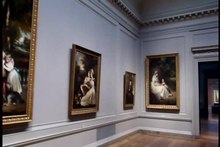American Art in Delaware

Look at the picture.

Read the questions.
Think about the topic.
Pre-Reading Questions
What types of things do you like to collect?
Would you like to have an art collection?
If you had some valuable artwork,what would do with it?

Vocabulary Practice
Read the following vocabulary words for pronunciation.
antique
assemble
century
decorative
estate
fortune
heir
inferior
patriotic
textile
Take a quiz to see if you know what these words mean.

Read and Pronounce
Read the text below out loud. Your tutor will listen and correct pronunciation errors.
American Art in Delaware
You have probably heard of the DuPont Company, which was founded by a family of the same name. But do you know about the museum that one of the family members began?
Henry Francis du Pont (1880-1969) was an heir to Delaware’s DuPont Company fortune. He was one of the first serious collectors of American decorative art objects –furniture, textiles, paintings, and other objects made in the United States between 1640 and 1840. American furniture and household objects had been considered inferior to those from Europe. But du Pont helped develop a new appreciation for American decorative arts. He created a legendary showplace for these objects on his family’s estate just outside of Wilmington, Delaware. In 1951 it was opened to the public as the Henry Francis du Pont Winterthur (pronounced winter-tour) Museum.
Du Pont assembled objects from his collection into 175 “period rooms,” each with examples of American antiques and decorative arts that followed a certain theme or period in early American history. For example, the du Pont Dining Room has furniture dating from the late 18th and early 19th centuries. And, because this was the time when the United States became a new nation, there is a patriotic theme in the room. Another example is the Chinese Parlor, which has furnishings that reflect Americans’ fascination with Asian culture during the 18th century. In these period rooms du Pont believed he could tell the story of the early United States through furniture and other decorative arts.

Talk with your tutor about this topic.
Use the expressions and vocabulary you learned.
Use the related resources below to learn more.
More Practice
Take a quiz to check you comprehension of the reading passage.
